Coho Salmon
Coho salmon, endangered in the state of California, are medium to large salmon with sizes up to 22lbs. While providing for a popular fishery in other areas of the Pacific Northwest, recreational angling for coho salmon in California is prohibited. The most reliable identification of these fish comes from the black jaw with white/grey gums.
The Coho Broodstock Recovery Program is for conservation of this endangered species. In 2001 coho salmon were rapidly disappearing leaving fewer numbers returning to tributaries within the Russian River drainage.
CDFW along with cooperation from the United States Army Corp of Engineers (USACE), the Sonoma County Water Agency, and the University of California Co-Operative Extension began capturing wild endangered coho fingerlings from the Russian River drainage and bringing them back to the hatchery to use as broodstock for spawning. Coho mature at the end of their third year, so before their first spawn each fish receives a Passive Integrated Transponder (PIT) embedded into their abdomen. The PIT tag has a number inscribed on it which, when read by a PIT tag reader, translates information on that individual fish that has been entered into the computer.The information stored is such as: length, weight and sexual maturity. Each fish also has a genetic sample taken from the caudal fin and is then sent to the National Oceanic and Atmospheric Administration (NOAA) South West Science Center in Santa Cruz, California for DNA analysis. Before the fish are spawned, a matrix, (or a spreadsheet detailing which female should be spawned with which male based on their PIT tag numbers) is created and received from the Science Center.
Coho spawning begins in mid- November and continues through February. The fish are sorted for sexual maturity. As all salmon naturally die after spawning, females that are ready to spawn are euthanized. An incision is made making it easy to remove the eggs. The males are sorted by PIT numbers that are compatible with the female. Males are squeezed to obtain sperm which is checked under a microscope for viability and mixed with the freshly taken eggs. Each female is spawned with up to four different males for genetic diversity. Fish that are not sexually mature are returned to a holding pond to be sorted on the next spawning day. The eggs are placed in an incubator and hatch in approximately 40 days. Initially the fry will subsist by absorbing their yolk sac. Once the sac is absorbed the fish are transferred to a start tank and fed with a fine powder feed several times a day. The feed increases in size as the fish grow larger.
Along with the continuous capturing of wild endangered coho fingerlings, a number of fish are kept from each female/male spawn for future brood stock spawning. The remaining fish are released at various sizes and at different times of the year throughout tributaries to the Russian River drainage. Since the program began, fish produced for release has increased each year. The increase of production is partly due to the advanced spawning and rearing techniques used to preserve the genetic integrity and wild characteristics of the species.
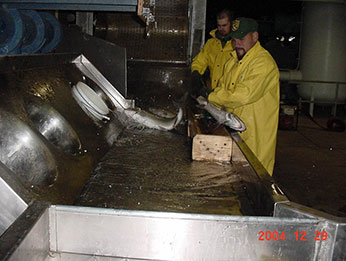 Sorting and spawning adult fish
Sorting and spawning adult fish
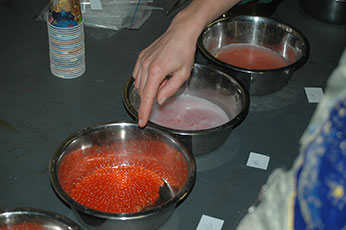 Selectively pairing adults for maximum genetic diversity
Selectively pairing adults for maximum genetic diversity
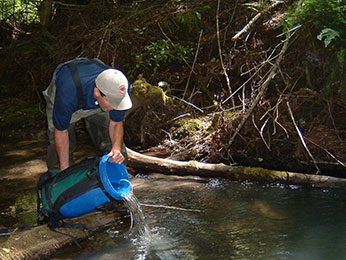 Releasing juvenile coho to a Russian River tributary
Releasing juvenile coho to a Russian River tributary
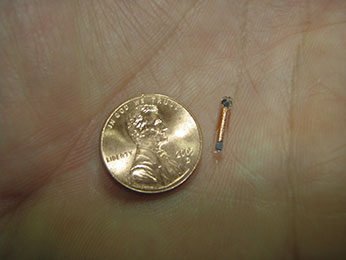 PIT Tag
PIT Tag
Steelhead Trout
Steelhead trout are an anadromous form of the rainbow trout that go to the ocean for one or more years and then return to spawn upstream, similar to a salmon. They differ from salmon in that a steelhead may spawn and return to the ocean, and then spawn again in another year.
Steelhead spawning begins in January and continues through Mid-April. Once the fish enter the channel they are crowded into the spawning area using a mechanical crowder. There, they are sedated with carbon dioxide for easier handling. They are checked for sex, measured for length and placed into an adult holding pond. Weekly the adult returns are sorted for sexual maturity. Fish ready for spawning are placed in a three chamber spawning table where the fish are sedated with carbon dioxide. The females are then air spawned, which means a small needle is placed in the female's abdomen filling the abdomen with air and pushing the eggs out the vent. The males’ sperm or "milt"; is then mixed with the eggs for fertilization. Each female is spawned with up to three different males for genetic diversity.
After the required numbers of eggs are taken, surplus adults are transported back to the Russian River.
The eggs are then placed into hatching jars and hatch in approximately 34 days. For several weeks the fry will subsist by absorbing the yolk sac attached to them. Once the yolk sac is absorbed the fry are fed with a fine powder feed several times throughout the day. The feed increases in size as the fish grow larger. When the fish are about 3 inches long they are transported outside to a yearling pond where they are raised until ready for release.
Warm Springs produces 300,000 Steelhead for release into Dry Creek, a tributary to the Russian River, at one year of age. Steelhead often live in fresh water up to two years before migrating to the ocean and usually return to spawn in their home streams after one or two years in the ocean.
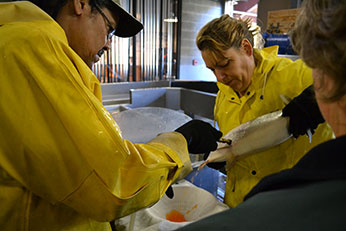 Air spawning adult female steelhead
Air spawning adult female steelhead
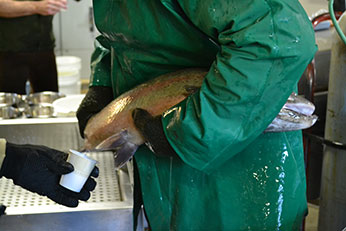 Obtaining “milt” from male steelhead
Obtaining “milt” from male steelhead
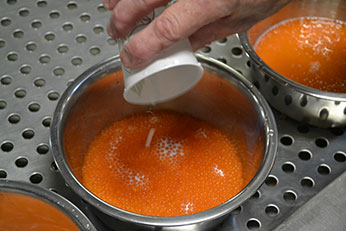 Adding milt to eggs for fertilization
Adding milt to eggs for fertilization
Warms Springs Hatchery main page